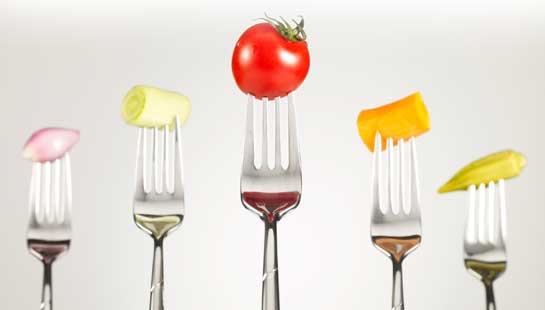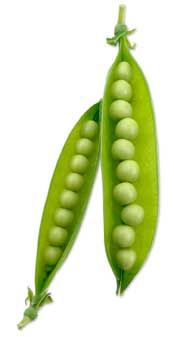
By NATALIE DIGATE MUTH, M.D., M.P.H., R.D.
Despite the darker, colder days that winter brings throughout most of the U.S., consumers still can count on a ready supply of an assortment of out-of-season fruits and vegetables in their local grocery store. In fact, the tomato—the star of the new book Tomatoland by ex-Gourmet magazine editor Barry
Tell Us What You Think
What will it take to encourage Americans to eat better? Legislation or taxation of unhealthy foods? Or will poor health be enough to make Americans improve their habits? Leave your feedback at the end of this article!
Estabrook—may be the most widely available off-season fruit, due in large part to the mass production of tomatoes in the Sunshine State of Florida. Estabrook argues that, while warm and sunny, Florida’s soil is unsuitable for growing a juicy, tasty and nutrient-dense tomato, which may explain the mediocre taste and quality of most tomatoes available in winter. This criticism of tomato production is the latest impetus for a growing “food movement.”
The recent boon in community gardens, farmers markets and availability of organic foods offers evidence of increased consumer demand for more wholesome, more sustainable, more environmentally friendly foods. At the same time, people are trying to save money and get the most nutritional value (and taste) from their food dollar. Given the increased interest in eating a diet of mostly wholesome foods on a budget, you are likely fielding questions from clients about how they not only can eat healthier food, but also simply eat better overall without having to spend more money.
The reality is that this is no simple undertaking. Most of the food readily available in the current environment is heavily processed with long ingredient lists of largely unrecognizable compounds. Food suppliers can voluntarily label their produce and other food items with “country-of-origin” labeling, but if they choose not to, it is difficult for a consumer to know where a food was grown or processed. In the current environment, it is cheap to get enough calories to sustain a family but, without careful planning, sustaining a family on a nutrient-dense and wholesome diet can be expensive. Despite these barriers, with your help, a motivated client can successfully adopt a more wholesome, environmentally friendly diet without breaking the family budget. Here’s how:
1. Buy in-season.
It is a major “success” of modern-day farming and the global economy that many fruits and vegetables “have no season.” Just as you can buy tomatoes year-round, even though summer is their prime growing season in the U.S., the season-to-season fluctuation in produce offerings at most major grocery store chains across the U.S. is minimal. If a client eats a tomato in Michigan in the dead of winter, he is eating a tomato shipped from far away and likely grown in a location not ideally suited for growing tomatoes. Not only will the taste of the tomato suffer, but it will cost more due to the extra expense and resources required to transport it across the country or world. Since there are not many fruits and vegetables that grow during the winter in Michigan, a client may be frustrated as to how he is expected to get his recommended allotment of fruits and vegetables without buying produce out of season. There are a few potential solutions. First, frozen produce not only has similar, if not better, nutritional value to the fresh stuff, it is typically picked at maximal ripeness and immediately frozen to retain robust flavor. And, frozen produce generally costs less than the fresh produce. In many cases, canned food also may be just as good as fresh produce, though it’s a good idea to check out the nutrition label to be sure that it does not contain excessive amounts of sodium (or opt for the “low sodium” version). With prior planning and a large freezer, fresh produced purchased in the summer growing months could be frozen for use in the off-season. Most produce has a freezer life of about six to eight months.
2. Read nutrition labels.
Fitness professionals have long encouraged clients to read nutrition labels to understand the calories, saturated fat, protein, fiber, sodium and other nutrients content of foods, but how often do you recommend that they carefully review the ingredient list? The mere length of the ingredient list can often clue a consumer in to how heavily processed a food is—with longer lists typically meaning more processing (though not always). Another clue is the recognizability of the ingredient list. If you can’t identify the majority of ingredients in a food, it is worth questioning the benefit of eating such a heavily processed mix of substances. Of course, in some cases a client will opt for these foods simply because they taste good or because another less-processed food is not available.
In addition to reviewing nutrition content and the ingredient lists, advise your clients to look out for other labels on product packaging. In some cases, the country-of-origin of the food will be listed, or other product claims may be prominently displayed on the front of the package. Consumers should be discerning about these labels. Manufacturers place them to encourage the purchase of items, but many of them are poorly regulated by the federal government and may be misleading. For example, many manufacturers include the label “natural,” but there is no standard definition for the term.
3. Shop locally.
Choosing locally grown foods whenever possible not only makes for a better-tasting and potentially healthier food item, but it also helps reduce the amount of environmental resources and energy that go into growing and shipping a crop long distances. In fact, choosing locally grown produce may ultimately impact the environment less and support health (and a family budget) even more than buying strictly organic foods. This is because organic foods are frequently grown abroad and transported thousands of miles to meet the growing demand in the U.S.

Access to wholesome, locally grown foods through farmers markets, community gardens and healthy school lunches has increased dramatically over the past several years. According to the U.S. Department of Agriculture’s National Directory of Farmers Markets, there are now more than 7,000 farmers markets, more than double the number from just a decade ago. Planting a small backyard garden, or even just growing a few herbs on the windowsill is also a great way to promote sustainable foods in addition to having a ready supply of delicious food available for family meals and snacks. It may require a bit of extra effort, but it's worthwhile to visit markets and grocery stores that support local famers or participate in food co-ops in which consumers pay a fee in exchange for a weekly box of in-season, locally grown produce.
4. Get informed.
Interest in the food movement has broadened as several popular and highly influential books and documentaries have questioned how food gets from the farm to a consumer’s plate and what implications the process has on human and environmental health (e.g., Eric Schlosser’s Fast Food Nation; Michael Pollan’s Omnivore’s Dilemma; Robert Kenner’s documentary Food, Inc.) Other books have also cast a light on the politics of food and the barriers to providing Americans with ready access to healthier, more wholesome and affordable foods (e.g., Marion Nestle’s Food Politics). Not surprisingly, this is a highly complex and political issue. Both fitness professionals and clients interested in getting aboard the food movement should strive to understand the issues around food in the U.S. While political debate about U.S. food policy has not made headlines in the past, some experts believe this may soon become a major political issue.
Consider the following quote from Michael Pollan, food activist, journalism professor at University of California, Berkeley, and author of The Omnivore’s Dilemma, published in a commentary at TheNation.com on October 3, 2011:
“Continuing to eat in a way that undermines health, soil, energy resources and social justice cannot be sustained without eventually leading to a breakdown.

Back in the 1970s it was impossible to say exactly where that breakdown would first be felt. Would it be the environment or the healthcare system that would buckle first? Now we know. We simply can’t afford the healthcare costs incurred by the current system of cheap food—which is why, sooner or later, we will find the political will to change it.”
While not everyone will agree with the policies and sentiment that Pollan expresses, it seems clear that the current environment—characterized by an abundance of calorie-dense, nutritionally poor foods, especially among low-income communities—has played a major role in the fattening of America, with the resulting severe health consequences including heart disease, type 2 diabetes, and other major diseases and disabilities.
Beyond learning more about the issues facing the food movement, informed consumers should make an extra effort to understand where their food comes from, how it was treated or modified, and what steps they can take to minimize exposure to harmful substances and maximize nutritional value. One useful resource you can offer your clients is the Environmental Working Group’s (EWG) “Shoppers Guide to Pesticides in Produce.” The EWG put together two useful lists for consumer—the “dirty dozen” list of the produce most saturated in pesticides (for which they recommend buying organic) and the “clean 15” list of the least-treated produce.
5. Consider grassroots efforts.
As the food movement takes hold and gains momentum, numerous grassroots efforts have taken shape. A few of these efforts are highlighted below with links for more information on how to get involved.

- Slow Food USA. The Slow Food movement is a global, grassroots movement that links the pleasure of food with a commitment to community and the environment. Slow Food USA is a network of local chapters with events, activities and advocacy efforts to promote more mindful, sustainable, healthy and environmentally friendly eating.
- FoodCorps. Similar to the AmeriCorps program for young service-minded educators, FoodCorps volunteers spend a year in low-income communities delivering nutrition education, building and tending school gardens, and bringing high-quality local food into public school cafeterias.
- Edible Schoolyard Project. The goal of the Edible Schoolyard Project is to transform the way schoolchildren think about food. One approach is to develop a resource for school and community leaders to share resources. Currently in development, the online resource center “will allow educational garden, kitchen and lunch programs across the nation to share their lessons and best practices. The site will also offer an interactive map to demonstrate the growing impact of the edible education movement as well as a gathering place for educators to connect with one another.”
- The Real Food Challenge. The Real Food Challenge is a network of college-student activists advocating for a shift of university food dollars away from the purchase of highly processed, industrial foods to instead support locally produced, ecologically sound, “real” food.
_____________________________________________________________________
 Natalie Digate Muth, M.D., M.P.H., R.D., is a pediatrics resident at UCLA Mattel Children’s Hospital. She’s also mom to two young children, Tommy (3) and Mariella (11 months).
Natalie Digate Muth, M.D., M.P.H., R.D., is a pediatrics resident at UCLA Mattel Children’s Hospital. She’s also mom to two young children, Tommy (3) and Mariella (11 months).